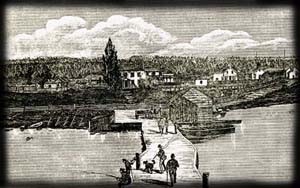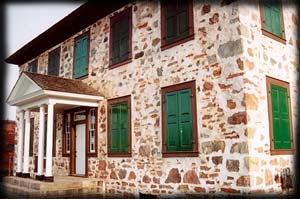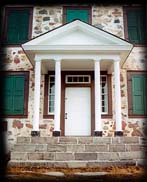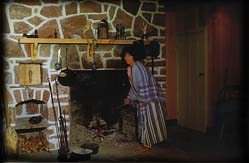|
|
HISTORICAL The story of the Ermatinger House is interwoven with the history of 19th Century Canada, with the tales of voyageurs, settlers, writers and artists who often spent the night at the stately stone house on the north side of the St. Mary's River as they made their way across Canada. Charles Oakes Ermatinger was the son of Laurenz Ermatinger, a Swiss immigrant to Canada and Jemima Oakes of Montreal. Members of Charles's extended family had been involved in the fur trade and, quite naturally, Charles gravitated in the same direction. It is assumed that Charles launched his fur trade career in 1797 or 1798 in the Sandy Lake area near the headwaters of the Mississippi River. It was here that he met and married Mannowe, the daughter of Katawabeda, an influential policy chief of the Sandy Lake tribe. Ermatinger was associated with the North West Company by 1799, the same time as the Company was expanding its post at Sault Ste. Marie and constructing a small lock system to facilitate the movement of canoes and their cargo around the Rapids of St. Mary. Ermatinger continued in the employ of the North West Company until 1805 when he was offered shares in the Company. Despite his previously good working relationship with the N.W.C., Charles and the Company went their separate ways in 1807. This led Charles to resume his status as an independent trader. With his wife and four children, he made his way to Sault Ste. Marie where he established a permanent residence and post.
Upon their arrival, Ermatinger and his employees began to build the post using materials and methods common to the region and to the time. A cabin to house the Ermatingers would have been the first to be constructed. The post itself would have been built of logs complete with a finished bark roof. The windows would have been covered with parchment and the chimney would have been made of compacted clay and grass,
The house and grounds, as viewed from the St. Mary's River, were imposing. Situated on 252 acres (thirty of which were cleared), the house measured thirty-five feet by forty-five feet. It was constructed using a typical Quebec masonry method: stones of varying sizes were applied to both faces of the walls and then covered with a lime mortar without any attempt at pointing.
The house is an immensely strong structure supported in the basement on huge peeled cedar logs fifteen or more inches in diameter and levelled on top by an adze. These logs span the full width of the house and are supported on a central spine wall twenty-seven inches thick. This same strength is apparent throughout the house. The interior petitions are of roughly dressed vertical timbers four inches thick, butted edge to edge, tongued at both ends and set between runners at floor and ceiling level in a style of framing called "en colonbage". This type of framing was common in Quebec where it was used as an alternative to log construction. Doors and windows were framed with six by six balks tenoned and mortised and used as a framework against which the masonry rested.
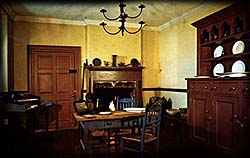  In 1814, American troops attacked Sault Ste. Marie with a force of 150 troops. They laid waste to the community, burning most structures , including the North West Company post. Ironically, Ermatinger's house escaped unscathed. When Gabriel Franchere arrived in Sault Ste. Marie on 31 July, 1814, he noted that the houses, stores and sawmills of the North West Company were still smoking. He further indicated that Ermatinger's "pretty establishment" and his "very elegant" house of stone were untouched. Ermatinger was never satisfied with the appearance of his house and spent copious amounts of time and money equipping and upgrading. Furnishings and decorative arts were regularly shipped from Montreal. The Ermatinger family left Sault Ste. Marie in 1828 following the death of Charles's brother Frederick William in Montreal. Following their departure, the house was variously occupied by a caretaker by the name of LaFond from 1828 until 1833 and then by a missionary by the name of William McMurray from 1833 until 1842, The Church of England paid twenty-five pounds a year for the use of the house a residence and mission. LaFond resumed his occupancy of the house following the departure of the McMurray's. By this time, however, the house had begun to fall into disrepair and the outbuildings were collapsing. Despite the state of decay, Joseph Wilson, Collector of Customs and Post Master, was anxious to live in the house. He remained the tenant until David Pim settled in Sault Ste. Marie in 1852 and acquired possession of the house. He turned it into the "Stone House Hotel". Pim was the first person to have legal title to the house and land. Over the next several years, the house served as a tavern, courthouse, post office, dance hall, tea room, and apartment building. It was purchased by the City of Sault Ste. Marie in 1965 and restored to its former position as "elegant mansion" at a cross roads of Canada's history on the St. Marys River. 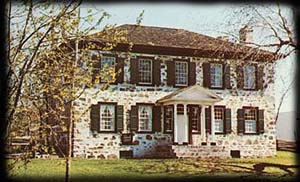 |


